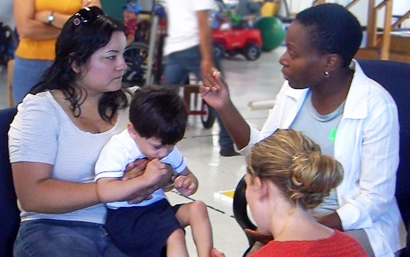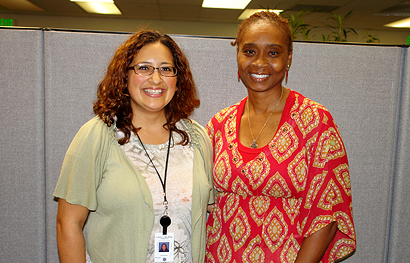
On the first day of autumn, we're asking County employees their favorite things about the season.
Autumn is my favorite season. One of the most spectacular sights I’ve ever seen was from the back seat window of a single engine plane while flying over northern Ohio in October. The colors of yellow, green, orange, red & brown were a sight to behold.
Joyce Easterman, HHSA
I like the leaves turning orange.
Vangie Carino, HHSA
I love the autumn colors; the leaves falling from the trees, the different weather climates, baking goodies when it’s too cold to be outside.
Yolanda Moeller, HHSA
I like that Idyllwild and Julian beckon and provide a multitude of sensory experiences!
Anne Fitzgerald, HHSA
It’s the changing of the leaves
The cold chill in the mornings
The smells of baking cookies, pumpkin pie, soups
The family gatherings, FOOTBALL!
Field trip to Julian
The romance of it all, I love Fall….it’s my favorite season!
Pearl Luciani-Howard, SDCERA
Autumn…
I celebrate my birthday
Start of school season
Memories of my first kiss after raking a pile of leaves and jumping in
Crisp air and the smell of burning wood
New TV shows
My mom’s delicious chili and now my own recipe
An extra hour of sleep
Many holidays and lots of family time
Jackie Collins, Communications
The drama in the skies…amazing cloud formations!
Angela Ryan, ARCC
My favorite season hands down! It’s right between the fun-packed summer days and the jam-packed month of December. I always feel like I have a new lease on life, love pumpkin anything. a time for reflection and of course giving thanks. There’s a calmness and color about fall that I embrace.
Selinda Hurtado-Miller, Civil Service Commission
Well, I often notice heavier traffic on my way to work when fall begins but that just allows me more time to listen to Bob Marley :) Fall means Charger football and Padre playoff games (sometimes). I tend to go to bed earlier which means I get up earlier and actually catch a sunrise which at times can be really beautiful. Hiking at many of our awesome San Diego spots becomes much more enjoyable during the cooler fall weather.
Richard Larrabee, HHSA
I like fall because of its distinctive atmosphere transition-- from the busy, hot summer into a gentle, cool weather. The changing autumn foliage never fails to amaze me! It makes me realize that nature has its timeless trend and abundance; from daring colors to stylish array of flowers; from harvest time to festivities. I also like the way stores and houses accessorize with orange, yellow, brown, red, burgundy, green and yellow. I also think that autumn is the perfect time to take pleasure in dressing up. Imagine the layers and assortments of clothing one can wear. But best of all, I like fall because it leads me to my most favorite season of all and I will reserve the bright ideas for later.
Ma Carmen Saline, HHSA
The Wind. I grew up in San Bernardino so the summers were hot & then the thunderstorms came around August. Around October we’d get the winds that came with cooler weather plus they smelled like fall. There is something wonderful about Southern California fall winds.
Mary Hammond, Probation
Fall for me is a introduction to beloved holidays where it seems that everyone is on one accord. I love the color of nature as it prepares for the winter (especially Christmas). I also love the weather because it reminds of favorite childhood memories of school days, football, and of course, the holidays!
Pendeza Lawrence, HHSA
I like that fall is a time of new beginnings. Traditionally, fall was a time when school started, new teachers, new classes, new projects. Now it is still a time that begs for change. For me, fall is a time to start something that will make me a better person.
Nancy Page, HHSA
I love getting all bundled up and going to the Charger game. We make a whole day of it – getting to the stadium early, doing a little tailgating, watching the team warm-up. It is a great family day for us.
Shauna Rooney, HHSA
I appreciate fall because of the change in atmospheric conditions. As an avid hobbyist photographer, sunrise and sunsets seem to be so much crisper versus the previous season. Also San Diego usually gets some different weather conditions during fall, which makes for some interesting photos. I also enjoy cooler temperatures! Oh, one last thing, I know that I will be smoking a couple of turkeys on Thanksgiving Day in my smoker. Yummy!
Pete Jacovino, ARCC
Fall is football and pumpkin spice lattes.
It’s scarves and boots and nights by the fire.
Fall is a perfect cold chill in the air and hot chili for dinner.
Fall is gold, burnt orange and yellow leaves.
Fall is hot chocolate, early dark nights, and time with family.
Fall is my favorite season.
Holly Crawford, Communications
I love the smell of wood smoke from my neighborhood fireplaces especially on crisp mornings.
Mikee Ritter, HHSA
When Fall comes – the air seems crisper and cleaner. Trees become pieces of art turning multicolored and more breathtaking. And fun holidays such as Halloween (my absolute favorite) and Thanksgiving happen! Costume parties and family gatherings! And best of all – it’s cool enough to wear the wonderful long sleeves and sweaters that hide so many flaws!!
Pauline Thomas, HHSA
Having grown up back East, I love the fall. There’s nothing better than having crispness in the air and crunchy leaves under foot. One of my favorite chores was to rake leaves into a large pile and jump into it, scattering leaves everywhere!
Barbara Crane, ARCC
I get a special “feeling” every Fall, it’s hard to describe but it’s a feeling of excitement, of new beginnings, a chance to start clean. Fall also makes me feel like nesting a little, getting my house in order in readiness for the Winter. The chill in the air makes me want to be cozy and warm with a hot chocolate and good friends. I love the Fall, it is my favorite season.
Tracy Watkins, General Services
This is my favorite time of year. I love the color of the sunsets, the colors of autumn, the breezy cooler temperatures, pumpkin pie, Halloween, etc. I could go on and on; I love it all!
Cassandra A. Tena, Human Resources
The things I love about the fall are the homemade soups I can start making, like Abondigas (meatball soup), Caldo de Res or Pollo (beef or chicken soup), and oh! Sunday mornings waking up to the smell of Menudo (tripe soup with hominy) or Pozole (pork soup with hominy) watching the leaves fall and wind blow out the kitchen window, then snuggling up on the couch for a good movie.
Kim Preciado, HHSA, Human Resources
I love seeing hundreds and hundreds of pumpkins on a farm. It is so bright and picturesque.
Imelda Holst, HHSA



